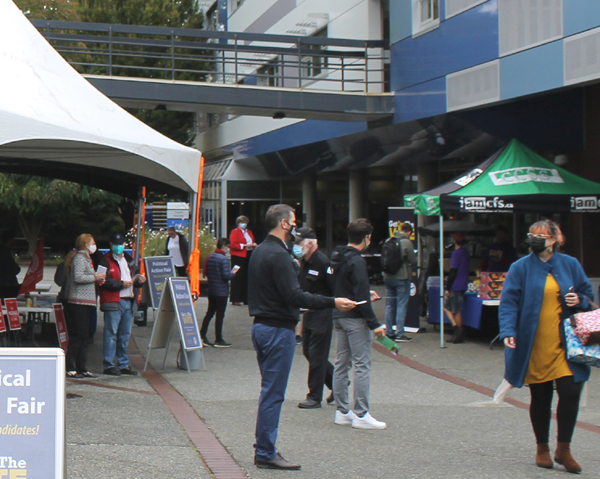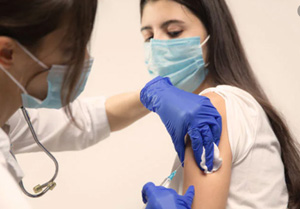
Saturday September 18, 2021 | VICTORIA, BC
EDITORIAL ANALYSIS by Mary P Brooke, B.Sc, Editor | Island Social Trends
The opportunity for a second dose of COVID vaccine after 28 days helps students get ‘fully vaccinated’ and boosts BC’s total tally of fully-vaccination people which is now at 78.9% of people age 12+ according to the BC Centre for Disease Control (BC CDC).
But the level of protection achieved with a second dose at 28 days is less than if you wait longer. Yesterday (September 17, 2021) BC Health issued this clarification in a statement to Island Social Trends:
“While people in BC can currently receive their second dose of COVID-19 vaccine 28 days after their first dose, public health strongly recommends waiting at least six weeks between doses to provide strong and long-lasting protection against the virus.”

Promoting the 28-day interval while fully knowing that a longer interval is better is somewhat shocking, if not unconscionable. And yet this is what is going on right now in BC. It’s like offering candy while saying it’s bad for you. And it’s going on right before our eyes, leaving people to figure this out on their own, if they ever do. Everyone who stands to gain by the shorter interval (for the running of their campus or business or event) is to some degree complicit in this.
Longer is better:
Provincial Health Officer Dr Bonnie Henry has said several times in sessions with the media that six to eight weeks is the desirable minimum period to wait between doses. Earlier this year (when most people eligible for a second dose were seniors and elders) her recommended optimum interval was 11 weeks.
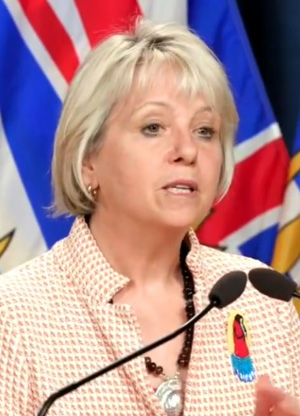
This means that people rushing to get their second dose promptly after 28 days are perhaps satisfying the requirement for getting their BC Vaccine Card, or to meet other stated requirements of ‘full vaccination’ (as in for employment or attending a post-secondary campus), But it sounds like they are being short-changed as to the fullest possible level of protection against infection, serious illness and death due to COVID-19 (i.e. SARS-CoV-2).
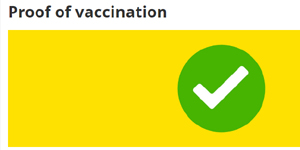
People who have a shorter interval between doses are likely to have a level of protection that is not as strong than if they had waited longer.
All of this talk about intervals between doses is almost entirely now about mRNA-type vaccines (Pfizer-BioNTech and Moderna). The AstraZeneca vaccine product (a viral vector type) was phased out of use in BC a few months ago, even though it is still a vaccine approved by Health Canada, due to some proven correlation of a type of blood clotting with having received the vaccine.
Conflicting agendas:
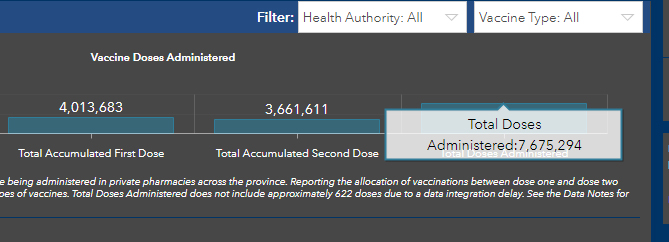
The BC Government wants to get its numbers up as to how many people are fully vaccinated in BC. Most people likely support that — i.e. to see the highest possible level of protection for the population (herd immunity).
As of September 17 there had been 7,675,294 doses administered (of which 3,661,611 of 47.7% were second doses); according to BC Health 78.9% of people age 12+ have been vaccinated with two doses in BC.
The provincial government also wants to help post-secondary campuses, employers and places of business and recreation be better satisfied as to the immunization levels of people who they interact with, are responsible for, or serve. In that respect, they are pushing the eligibility for a second dose as being 28 days.
[Links to campus COVID Information pages: UVic (Victoria) | VIU (Nanaimo)| Camosun (Victoria/Saanich) | UBC (Vancouver) | RRU (Colwood) | SFU (Burnaby | Surrey | Vancouver) ]
But BC Health is also stating that six to eight weeks (i.e. 42 to 56 days) is the recommended interval for stronger protection.
These are conflicting agendas — political and socioeconomic expediency up against actually the fullest possible protection of people’s health. It leaves some people less protected than others — not by mistake or oversight, but with the full knowledge of this failure to immunize all British Columbians equitably.
Leaving young adults to last:
It should also be noted that it’s young adults (in the 20 to 39 age group) that are most likely among those being herded into the 28-day interval category. That’s due almost entirely to the BC Government’s agreement with Provincial Health Officer Dr Bonnie Henry’s immunization plan that was age-based (from eldest, down) as a way to prevent death.
While of course limiting the number of deaths due to COVID is a desirable goal, there was limited thought (or action) put into the broader aspects of this pandemic on the mental and physical aspects of health for that sector of the population (young adults) who are the backbone of the long-term best interests of society — i.e. having families and participating in the work force.
No one should be surprised at the anger generating among young adults over this poorly-handled scenario. The worst of the long-term outcomes are among their age group, not the least of which are long-haul physical affects (chronic illness), the trauma of being left to last, the loss of employment and career-building, the indelible impacts of interruptions to education, the strain of interrupted or lost social connections, disruption and loss to families, and much more.
Booster shot?
The disconnect between ‘eligible interval’ and ‘best interval’ behooves the question of whether people with a shorter dosage-interval will need a booster (third shot) sooner than later, and actually be in more need of such a shot than people who had more than six weeks between doses.

Dr Henry has told media in recent months that a booster shot will likely be required at some future point, given that the COVID virus is here to stay. Full eradication of the virus could take years or decades, until the entire global population is vaccinated.
Meanwhile, in alignment with Dr Henry’s public statement about third doses at this time, BC Health also said in the September 17 statement received by Island Social Trends that “public health is only recommending a third dose of vaccine for those who are severely immunocompromised”. That list has been provided by BC Health as:
- Have had a solid organ transplant
- Have received treatment for lymphoma or a malignant hematological condition (like myeloma or leukemia) in January 2021 or later
- Have received treatment with any anti-CD20 agents (such as rituximab, ocrelizumab, ofatumumab, obinutuzumab, ibritumomab or tositumomab) in January 2020 or later
- Have been treated on B-cell depleting agents (such as epratuzumab, MEDI-551, belimumab, BR3-Fc, AMG-623, Atacicept, anti-BR3 or alemtuzumab) in January 2020 or later
- Have combined immune deficiencies affecting T-cells, immune dysregulation or type 1 interferon defects
- Have had bone marrow or stem cell transplant in September 2019 or later, or are still taking immunosuppressant medications related to transplant
Making your own choice:
Much of the success of anyone navigating this pandemic (ongoing officially since March 17, 2020 in BC) has been able making informed choices. The type, amount and clarity of information about COVID has not been consistent and not always clear.
Public health leaders and government officials plead forgiveness over this situation being ‘unprecedented’ and ‘always-changing’. In some respects, people are rolling with the punches of that theme. But when it comes to conflicting agendas like the dosage interval, the government and public health need to be held to account in a more strident way.
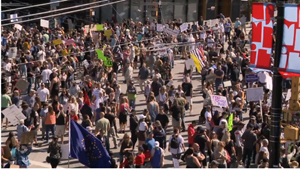
It’s tough enough for people to make informed choices. Following epidemiology explanations and the flurry of COVID-19 case stats for now about 20 months, people have enough understanding to make sense of things.
But government really has dropped a lot of responsibility into the hands of its citizens. A bit of straight-shooting (such as is required now around the dosage interval) will be appreciated by most people; trying to skirt around it actually serves to undermine the credibility that public health has tried to build in BC during the pandemic.
Protests:
If government wonders why people are angry and protesting, this mishmash of information about the pandemic and leaving dangerous situations to be sorted out by individuals, families, businesses, communities and institutions is a big part of the problem. A self-made problem.
A gentle slap on the wrist to protesters who entered schools this past week and swarmed outside hospitals the week before that seems odd. Yes, in a free society there is a right to protest.
But nice words to ask them to stop will not be enough. It’s important to recognize and acknowledge the root causes of the anger that people are experiencing around COVID realities.
Simple, clear communication — and ideally consistent across Canada — will be part of the solution to tamping down the anger that has been pushed to the surface during this health crisis.
And being straight-up in messaging about dosage intervals would be a good place to start. Something like: “The interval between your first dose and your second dose can be as short as 28 days, but in BC we recommend 42 to 56 days for greatest long-term effectiveness.” People won’t mind the honesty, in fact they will appreciate it.
===== ABOUT THE WRITER:
Mary P Brooke, is the editor and publisher of Island Social Trends. She holds a B.Sc. in health sciences. As a professional journalist she has covered the daily news of the SARS-CoV-2 virus and resulting pandemic since January 2020 (before it was officially declared as a pandemic in BC). She also holds a Certificate in Public Relations, with an eye to how the delivery of public messaging through mass media can be done effectively.
===== RELATED:
COVID LINKS & RESOURCES (including school districts and campuses)
BC COVID Immunization Plan (BC Government)
Vancouver Island: COVID infections in over 1,600 kids & teens (September 16, 2021)
PHAC: Same COVID vaccines in Canada, new names (September 16, 2021)
Politicians and public health: delicate dance toward a new post-COVID normal (April 19, 2020)




